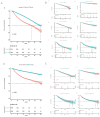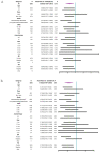Survival Comparisons between Breast Conservation Surgery and Mastectomy Followed by Postoperative Radiotherapy in Stage I-III Breast Cancer Patients: Analysis of the Surveillance, Epidemiology, and End Results (Seer) Program Database
- PMID: 36005190
- PMCID: PMC9406949
- DOI: 10.3390/curroncol29080452
Survival Comparisons between Breast Conservation Surgery and Mastectomy Followed by Postoperative Radiotherapy in Stage I-III Breast Cancer Patients: Analysis of the Surveillance, Epidemiology, and End Results (Seer) Program Database
Abstract
Background: This study aims to evaluate the overall and breast cancer-specific survival (BCSS) after breast-conserving surgery (BCS) plus radiotherapy (RT) compared with mastectomy plus RT in resectable breast cancer. Moreover, the aim is to also identify the subgroups who benefit from BCS plus RT and establish a predictive nomogram for stage II patients. Methods: Stage I−III breast cancer patients were identified from the Surveillance, Epidemiology, and End Results (SEER) database between 1990 and 2016. Patients with available clinical information were split into two groups: BCS plus RT and mastectomy plus RT. Kaplan−Meier survival analysis, univariate and multivariate regression analysis, and propensity score matching were used in the study. Hazard ratio (HR) was calculated based on stratified Cox univariate regression analyses. A prognostic nomogram by multivariable Cox regression model was developed for stage II patients, and consistency index (C-index) and calibration curve were used to evaluate the accuracy of the nomogram in the training and validation set. Results: A total of 24,590 eligible patients were enrolled. The difference in overall survival (OS) and BCSS remained significant in stage II patients both before and after PSM (after PSM: OS: HR = 0.8536, p = 0.0115; BCSS: HR = 0.7803, p = 0.0013). In stage II patients, the survival advantage effect of BCS plus RT on OS and BCSS was observed in the following subgroups: any age, smaller tumor size (<1 cm), stage IIA (T2N0, T0−1N1), ER (+), and any PR status. Secondly, the C-indexes for BCSS prediction was 0.714 (95% CI 0.694−0.734). The calibration curves showed perfect agreement in both the training and validation sets. Conclusions: BCS plus RT significantly improved the survival rates for patients of stage IIA (T2N0, T0−1N1), ER (+). For stage II patients, the nomogram was a good predictor of 5-, 10-, and 15-year BCSS. Our study may help guide treatment decisions and prolong the survival of stage II breast cancer patients.
Keywords: SEER; breast cancer; breast-conserving surgery plus radiotherapy; mastectomy plus radiotherapy; prognostic nomogram.
Conflict of interest statement
The authors declare no conflict of interest.
Figures




Similar articles
-
Additional radiotherapy to breast-conserving surgery is an optional treatment for de novo stage IV breast cancer: A population-based analysis.Cancer Med. 2021 Mar;10(5):1634-1643. doi: 10.1002/cam4.3751. Epub 2021 Feb 14. Cancer Med. 2021. PMID: 33586323 Free PMC article.
-
Comparison of breast-conserving surgery without radiotherapy and mastectomy in the treatment of elderly patients with early breast cancer: A PSM and SEER database study.Cancer Med. 2023 Jul;12(14):15229-15245. doi: 10.1002/cam4.6210. Epub 2023 Jun 3. Cancer Med. 2023. PMID: 37269188 Free PMC article.
-
The different outcomes between breast-conserving surgery plus radiotherapy and mastectomy in metaplastic breast cancer: A population-based study.PLoS One. 2021 Sep 2;16(9):e0256893. doi: 10.1371/journal.pone.0256893. eCollection 2021. PLoS One. 2021. PMID: 34473783 Free PMC article.
-
Predicting the Impact of Treatment Options on Survival and Breast Conservation in Patients with Ductal Carcinoma in Situ (DCIS) [Internet].Washington (DC): Patient-Centered Outcomes Research Institute (PCORI); 2020 Jan. Washington (DC): Patient-Centered Outcomes Research Institute (PCORI); 2020 Jan. PMID: 39038116 Free Books & Documents. Review.
-
Prognostic nomograms for young breast cancer: A retrospective study based on the SEER and METABRIC databases.Cancer Innov. 2024 Oct 25;3(6):e152. doi: 10.1002/cai2.152. eCollection 2024 Dec. Cancer Innov. 2024. PMID: 39464427 Free PMC article. Review.
Cited by
-
Pathologic Response of Associated Ductal Carcinoma In Situ to Neoadjuvant Systemic Therapy: A Systematic Review.Cancers (Basel). 2022 Dec 20;15(1):13. doi: 10.3390/cancers15010013. Cancers (Basel). 2022. PMID: 36612009 Free PMC article. Review.
-
Surgical options for patients with early-stage breast cancer and pathogenic germline variants: an oncologist perspectives.Front Oncol. 2023 Sep 14;13:1265197. doi: 10.3389/fonc.2023.1265197. eCollection 2023. Front Oncol. 2023. PMID: 37781190 Free PMC article. Review.
-
Are Current Survival Prediction Tools Useful When Treating Subsequent Skeletal-related Events From Bone Metastases?Clin Orthop Relat Res. 2024 Sep 1;482(9):1710-1721. doi: 10.1097/CORR.0000000000003030. Epub 2024 Mar 22. Clin Orthop Relat Res. 2024. PMID: 38517402
-
Epidemiology trends and progress in breast cancer survival: earlier diagnosis, new therapeutics.Curr Opin Oncol. 2023 Nov 1;35(6):612-619. doi: 10.1097/CCO.0000000000000991. Epub 2023 Sep 7. Curr Opin Oncol. 2023. PMID: 37681462 Free PMC article.
-
Establishment and validation survival prediction models for T1 locally advanced breast cancer after breast conservation surgery versus mastectomy.Sci Rep. 2025 Apr 9;15(1):12189. doi: 10.1038/s41598-025-91205-7. Sci Rep. 2025. PMID: 40204827 Free PMC article.
References
-
- Veronesi U., Cascinelli N., Mariani L., Greco M., Saccozzi R., Luini A., Aguilar M., Marubini E. Twenty-year follow-up of a randomized study comparing breast-conserving surgery with radical mastectomy for early breast cancer. N. Engl. J. Med. 2002;347:1227–1232. doi: 10.1056/NEJMoa020989. - DOI - PubMed
-
- Fisher B., Anderson S., Bryant J., Margolese R.G., Deutsch M., Fisher E.R., Jeong J.H., Wolmark N. Twenty-year follow-up of a randomized trial comparing total mastectomy, lumpectomy, and lumpectomy plus irradiation for the treatment of invasive breast cancer. N. Engl. J. Med. 2002;347:1233–1241. doi: 10.1056/NEJMoa022152. - DOI - PubMed
-
- Litière S., Werutsky G., Fentiman I.S., Rutgers E., Christiaens M.R., Van Limbergen E., Baaijens M.H., Bogaerts J., Bartelink H. Breast conserving therapy versus mastectomy for stage I-II breast cancer: 20 year follow-up of the EORTC 10801 phase 3 randomised trial. Lancet Oncol. 2012;13:412–419. doi: 10.1016/S1470-2045(12)70042-6. - DOI - PubMed
Publication types
MeSH terms
LinkOut - more resources
Full Text Sources
Medical
Research Materials
Miscellaneous

